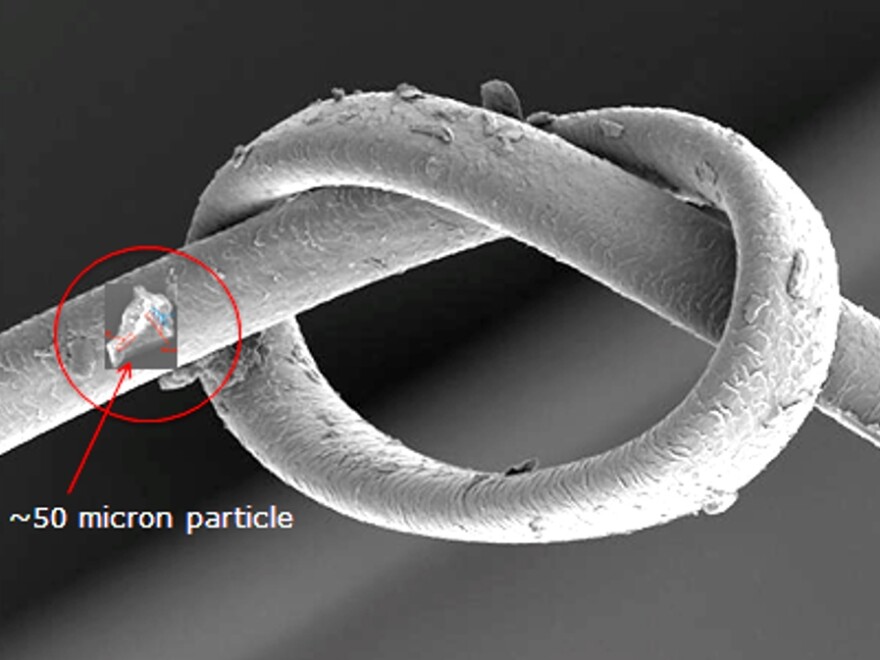A Boise State University professor is trying to solve a historical mystery.
Darryl Butt is trying to figure out who was buried in an Egyptian sarcophagus. Butt, however, is not an archeologist or historian. He’s a materials scientist and associate director of Idaho’s Center for Advanced Energy Studies. He mostly works with nuclear fuels. Butt says his involvement started with a chance meeting with someone from the Walters Museum in Maryland.
“I guess you could say I was talking up our capabilities at Boise State and in the state of Idaho,” Butt says. “And he realized that we might be able to contribute to the understanding with some of our tools.”
The Walters Museum owns a portrait that was entombed with an Egyptian mummy between 100 and 200 A.D. The painting is of a bearded man but no one knows who the picture represents. The museum sent Butt a fleck of purple paint almost too small to see with the naked eye.
“It took us the better part of two days just to find the particle in the package,” Butt says. “Once we found it, it took us a couple more days to transfer it into some of our equipment.”
The first piece of equipment was a Focused Ion Beam which Butt used to cut the sample into five smaller pieces. He ran those pieces through a transition electron microscope and an atom probe.

A History Mystery
In the first centuries A.D. the Roman Empire ruled Egypt. Egyptian elites, who were ethnically Greek, had adopted ancient burial customs like turning bodies into mummies. But they started burying these mummies with realistic portraits of what the person looked like when he or she was alive.
These portraits are a curious blend of Egyptian, Roman and Greek traditions. They captivated European and American collectors in the 19th century when most of them were discovered. And that’s the problem: the portraits were so popular they were sold before archeologists could study where they came from. Almost nothing is known about who these people were.
The Walters Museum is working with the Getty Museum in California and the British Museum in London to research the mummy portraits. They’re using what might be described as traditional methods. Butt on the other hand, is trying to figure out how the pigments used to paint the portrait were made.
“Purple pigments are a bit rare,” Butt explains. “It appears that it is derived from what’s called a cochineal insect. And when you essentially squish these things, they produce carminic acid which is a bright red.”

This technique is still used today. Butt notes people who wear red lipstick may have this same bug on their mouths. Butt’s sample however, is purple. He says the ancient painter added in other substances like chrome.
“This is actually a pretty high technology pigment," Butt says. "It’s a nano-composite of a polymer mixed with ceramic particles and organics. It was a fairly sophisticated process.”
Butt hopes what he’s learning about the pigment will help others figure out whose portrait it was used to paint. They might, for example, be able to match some of the minerals in the pigment to a specific place in Egypt or a nearby area. Or if historians know about the technique used to create the painting, they might be able to match it to descriptions in existing records and trace it to known practices of a particular family.
“We speculate that [the portrait represents] someone of importance based on the detailed artwork," Butt says. "It’s actually a beautiful piece of art. And also the nature of the pigment suggests quite a bit of money went into producing this piece of art.”
Butt took on this project for a couple of reasons. One, his hobby is painting. He likes to mix his own pigments and work in traditional techniques. Second, he loves the idea of people from multiple disciplines coming together to work on complex problems.
Butt has also found the work gets his students really excited.
“There’s something about getting this sort of human connection to what you’re working on,” Butt says. “In a sense we’re studying a person, a piece of history. There’s a lot more rewards to the research other than just the technical skills you get out of it.”
Find reporter Adam Cotterell on Twitter @cotterelladam
Copyright 2014 Boise State Public Radio


